Communication Issues Faced by Lawyers with Indigenous People
VerifiedAdded on 2023/06/09
|8
|2094
|389
AI Summary
This essay discusses the issues faced by lawyers in communicating with indigenous people and the role of aboriginal kinship structure in improving communication. It also highlights the need for better access to justice for indigenous people.
Contribute Materials
Your contribution can guide someone’s learning journey. Share your
documents today.

Running head: ESSAY 0
WRITTEN AND COMMUNICATION FOR LEGAL PROFESSION
AUGUST 2, 2018
STUDENT DETAILS:
WRITTEN AND COMMUNICATION FOR LEGAL PROFESSION
AUGUST 2, 2018
STUDENT DETAILS:
Secure Best Marks with AI Grader
Need help grading? Try our AI Grader for instant feedback on your assignments.
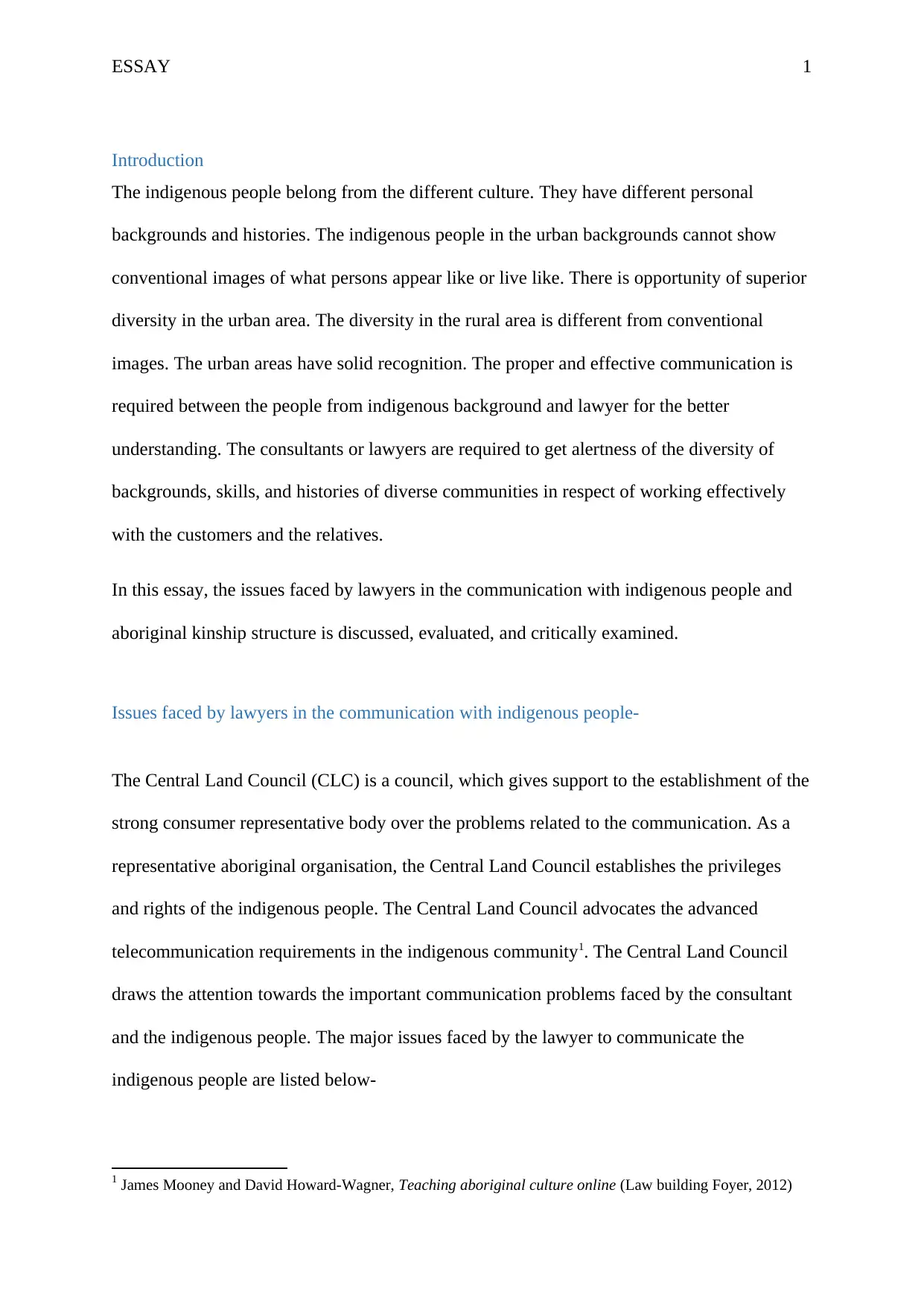
ESSAY 1
Introduction
The indigenous people belong from the different culture. They have different personal
backgrounds and histories. The indigenous people in the urban backgrounds cannot show
conventional images of what persons appear like or live like. There is opportunity of superior
diversity in the urban area. The diversity in the rural area is different from conventional
images. The urban areas have solid recognition. The proper and effective communication is
required between the people from indigenous background and lawyer for the better
understanding. The consultants or lawyers are required to get alertness of the diversity of
backgrounds, skills, and histories of diverse communities in respect of working effectively
with the customers and the relatives.
In this essay, the issues faced by lawyers in the communication with indigenous people and
aboriginal kinship structure is discussed, evaluated, and critically examined.
Issues faced by lawyers in the communication with indigenous people-
The Central Land Council (CLC) is a council, which gives support to the establishment of the
strong consumer representative body over the problems related to the communication. As a
representative aboriginal organisation, the Central Land Council establishes the privileges
and rights of the indigenous people. The Central Land Council advocates the advanced
telecommunication requirements in the indigenous community1. The Central Land Council
draws the attention towards the important communication problems faced by the consultant
and the indigenous people. The major issues faced by the lawyer to communicate the
indigenous people are listed below-
1 James Mooney and David Howard-Wagner, Teaching aboriginal culture online (Law building Foyer, 2012)
Introduction
The indigenous people belong from the different culture. They have different personal
backgrounds and histories. The indigenous people in the urban backgrounds cannot show
conventional images of what persons appear like or live like. There is opportunity of superior
diversity in the urban area. The diversity in the rural area is different from conventional
images. The urban areas have solid recognition. The proper and effective communication is
required between the people from indigenous background and lawyer for the better
understanding. The consultants or lawyers are required to get alertness of the diversity of
backgrounds, skills, and histories of diverse communities in respect of working effectively
with the customers and the relatives.
In this essay, the issues faced by lawyers in the communication with indigenous people and
aboriginal kinship structure is discussed, evaluated, and critically examined.
Issues faced by lawyers in the communication with indigenous people-
The Central Land Council (CLC) is a council, which gives support to the establishment of the
strong consumer representative body over the problems related to the communication. As a
representative aboriginal organisation, the Central Land Council establishes the privileges
and rights of the indigenous people. The Central Land Council advocates the advanced
telecommunication requirements in the indigenous community1. The Central Land Council
draws the attention towards the important communication problems faced by the consultant
and the indigenous people. The major issues faced by the lawyer to communicate the
indigenous people are listed below-
1 James Mooney and David Howard-Wagner, Teaching aboriginal culture online (Law building Foyer, 2012)
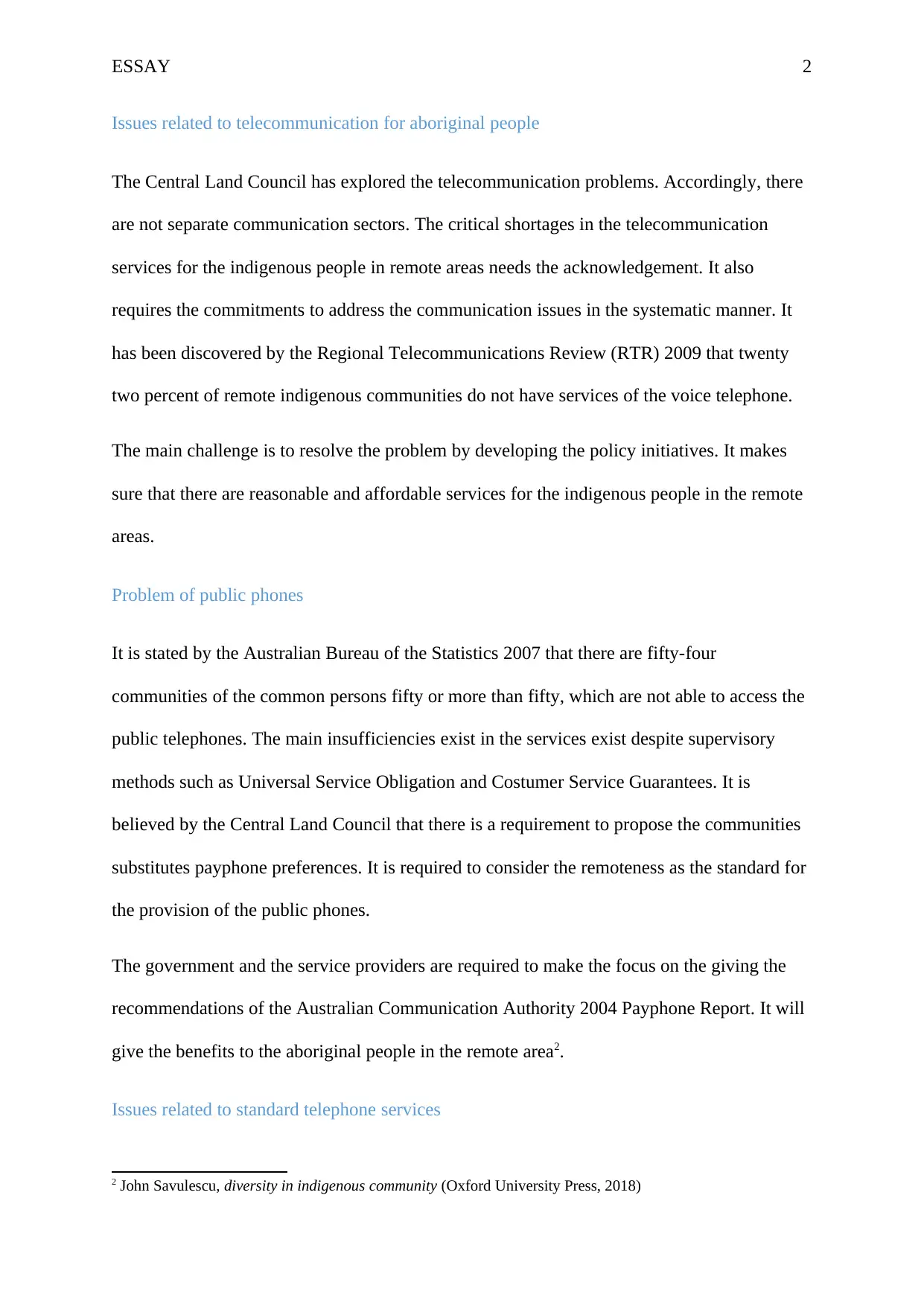
ESSAY 2
Issues related to telecommunication for aboriginal people
The Central Land Council has explored the telecommunication problems. Accordingly, there
are not separate communication sectors. The critical shortages in the telecommunication
services for the indigenous people in remote areas needs the acknowledgement. It also
requires the commitments to address the communication issues in the systematic manner. It
has been discovered by the Regional Telecommunications Review (RTR) 2009 that twenty
two percent of remote indigenous communities do not have services of the voice telephone.
The main challenge is to resolve the problem by developing the policy initiatives. It makes
sure that there are reasonable and affordable services for the indigenous people in the remote
areas.
Problem of public phones
It is stated by the Australian Bureau of the Statistics 2007 that there are fifty-four
communities of the common persons fifty or more than fifty, which are not able to access the
public telephones. The main insufficiencies exist in the services exist despite supervisory
methods such as Universal Service Obligation and Costumer Service Guarantees. It is
believed by the Central Land Council that there is a requirement to propose the communities
substitutes payphone preferences. It is required to consider the remoteness as the standard for
the provision of the public phones.
The government and the service providers are required to make the focus on the giving the
recommendations of the Australian Communication Authority 2004 Payphone Report. It will
give the benefits to the aboriginal people in the remote area2.
Issues related to standard telephone services
2 John Savulescu, diversity in indigenous community (Oxford University Press, 2018)
Issues related to telecommunication for aboriginal people
The Central Land Council has explored the telecommunication problems. Accordingly, there
are not separate communication sectors. The critical shortages in the telecommunication
services for the indigenous people in remote areas needs the acknowledgement. It also
requires the commitments to address the communication issues in the systematic manner. It
has been discovered by the Regional Telecommunications Review (RTR) 2009 that twenty
two percent of remote indigenous communities do not have services of the voice telephone.
The main challenge is to resolve the problem by developing the policy initiatives. It makes
sure that there are reasonable and affordable services for the indigenous people in the remote
areas.
Problem of public phones
It is stated by the Australian Bureau of the Statistics 2007 that there are fifty-four
communities of the common persons fifty or more than fifty, which are not able to access the
public telephones. The main insufficiencies exist in the services exist despite supervisory
methods such as Universal Service Obligation and Costumer Service Guarantees. It is
believed by the Central Land Council that there is a requirement to propose the communities
substitutes payphone preferences. It is required to consider the remoteness as the standard for
the provision of the public phones.
The government and the service providers are required to make the focus on the giving the
recommendations of the Australian Communication Authority 2004 Payphone Report. It will
give the benefits to the aboriginal people in the remote area2.
Issues related to standard telephone services
2 John Savulescu, diversity in indigenous community (Oxford University Press, 2018)
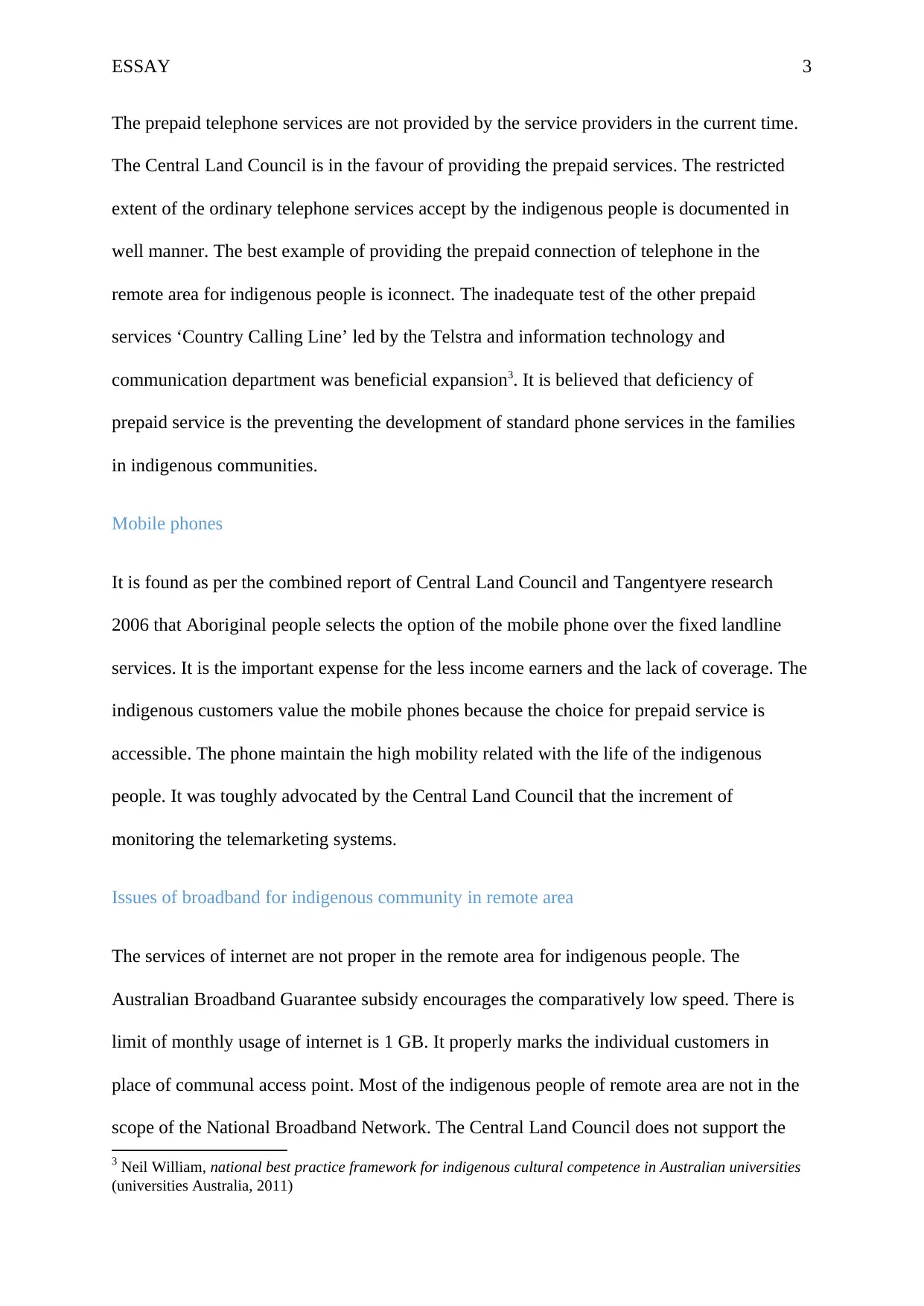
ESSAY 3
The prepaid telephone services are not provided by the service providers in the current time.
The Central Land Council is in the favour of providing the prepaid services. The restricted
extent of the ordinary telephone services accept by the indigenous people is documented in
well manner. The best example of providing the prepaid connection of telephone in the
remote area for indigenous people is iconnect. The inadequate test of the other prepaid
services ‘Country Calling Line’ led by the Telstra and information technology and
communication department was beneficial expansion3. It is believed that deficiency of
prepaid service is the preventing the development of standard phone services in the families
in indigenous communities.
Mobile phones
It is found as per the combined report of Central Land Council and Tangentyere research
2006 that Aboriginal people selects the option of the mobile phone over the fixed landline
services. It is the important expense for the less income earners and the lack of coverage. The
indigenous customers value the mobile phones because the choice for prepaid service is
accessible. The phone maintain the high mobility related with the life of the indigenous
people. It was toughly advocated by the Central Land Council that the increment of
monitoring the telemarketing systems.
Issues of broadband for indigenous community in remote area
The services of internet are not proper in the remote area for indigenous people. The
Australian Broadband Guarantee subsidy encourages the comparatively low speed. There is
limit of monthly usage of internet is 1 GB. It properly marks the individual customers in
place of communal access point. Most of the indigenous people of remote area are not in the
scope of the National Broadband Network. The Central Land Council does not support the
3 Neil William, national best practice framework for indigenous cultural competence in Australian universities
(universities Australia, 2011)
The prepaid telephone services are not provided by the service providers in the current time.
The Central Land Council is in the favour of providing the prepaid services. The restricted
extent of the ordinary telephone services accept by the indigenous people is documented in
well manner. The best example of providing the prepaid connection of telephone in the
remote area for indigenous people is iconnect. The inadequate test of the other prepaid
services ‘Country Calling Line’ led by the Telstra and information technology and
communication department was beneficial expansion3. It is believed that deficiency of
prepaid service is the preventing the development of standard phone services in the families
in indigenous communities.
Mobile phones
It is found as per the combined report of Central Land Council and Tangentyere research
2006 that Aboriginal people selects the option of the mobile phone over the fixed landline
services. It is the important expense for the less income earners and the lack of coverage. The
indigenous customers value the mobile phones because the choice for prepaid service is
accessible. The phone maintain the high mobility related with the life of the indigenous
people. It was toughly advocated by the Central Land Council that the increment of
monitoring the telemarketing systems.
Issues of broadband for indigenous community in remote area
The services of internet are not proper in the remote area for indigenous people. The
Australian Broadband Guarantee subsidy encourages the comparatively low speed. There is
limit of monthly usage of internet is 1 GB. It properly marks the individual customers in
place of communal access point. Most of the indigenous people of remote area are not in the
scope of the National Broadband Network. The Central Land Council does not support the
3 Neil William, national best practice framework for indigenous cultural competence in Australian universities
(universities Australia, 2011)
Secure Best Marks with AI Grader
Need help grading? Try our AI Grader for instant feedback on your assignments.
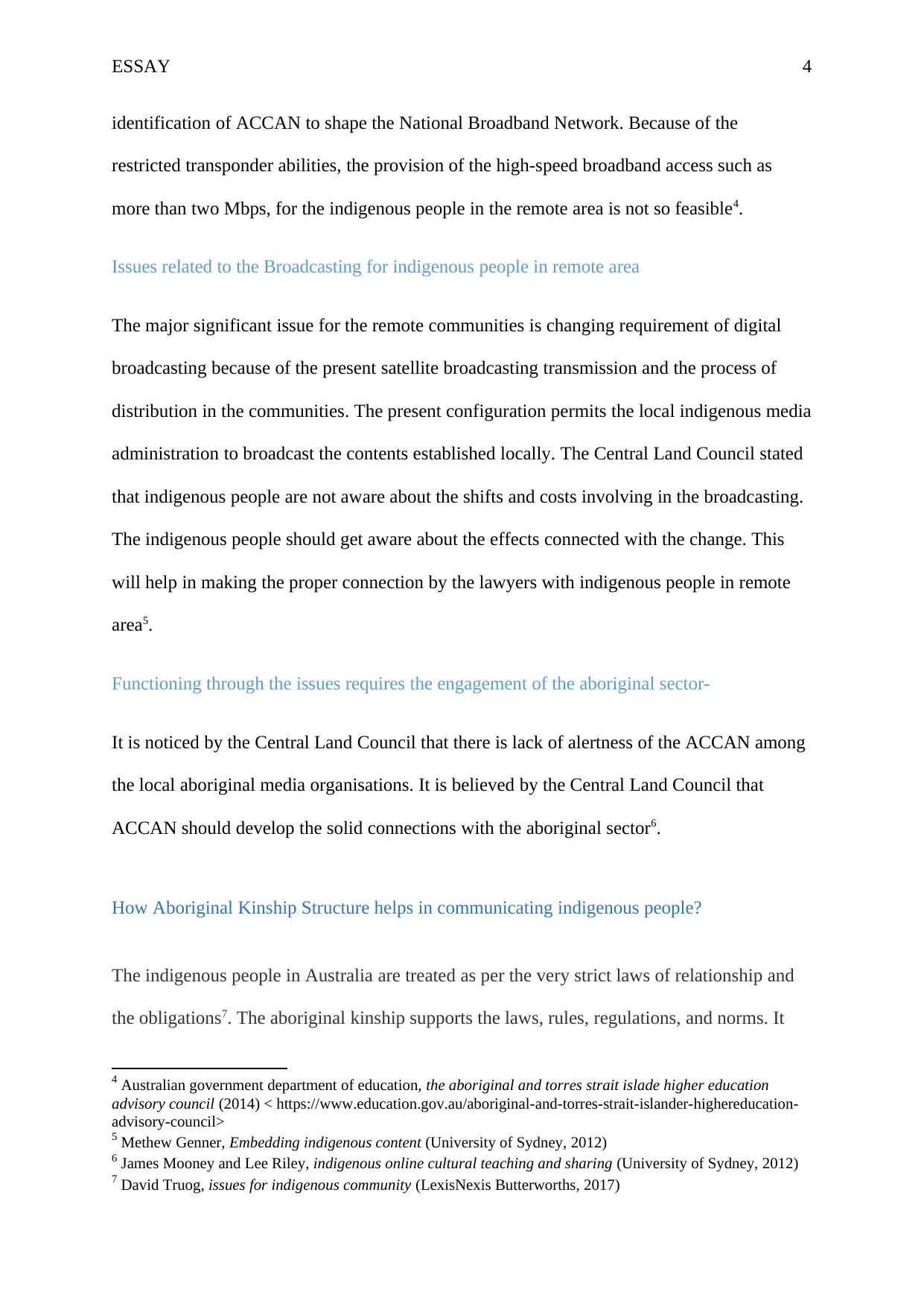
ESSAY 4
identification of ACCAN to shape the National Broadband Network. Because of the
restricted transponder abilities, the provision of the high-speed broadband access such as
more than two Mbps, for the indigenous people in the remote area is not so feasible4.
Issues related to the Broadcasting for indigenous people in remote area
The major significant issue for the remote communities is changing requirement of digital
broadcasting because of the present satellite broadcasting transmission and the process of
distribution in the communities. The present configuration permits the local indigenous media
administration to broadcast the contents established locally. The Central Land Council stated
that indigenous people are not aware about the shifts and costs involving in the broadcasting.
The indigenous people should get aware about the effects connected with the change. This
will help in making the proper connection by the lawyers with indigenous people in remote
area5.
Functioning through the issues requires the engagement of the aboriginal sector-
It is noticed by the Central Land Council that there is lack of alertness of the ACCAN among
the local aboriginal media organisations. It is believed by the Central Land Council that
ACCAN should develop the solid connections with the aboriginal sector6.
How Aboriginal Kinship Structure helps in communicating indigenous people?
The indigenous people in Australia are treated as per the very strict laws of relationship and
the obligations7. The aboriginal kinship supports the laws, rules, regulations, and norms. It
4 Australian government department of education, the aboriginal and torres strait islade higher education
advisory council (2014) < https://www.education.gov.au/aboriginal-and-torres-strait-islander-highereducation-
advisory-council>
5 Methew Genner, Embedding indigenous content (University of Sydney, 2012)
6 James Mooney and Lee Riley, indigenous online cultural teaching and sharing (University of Sydney, 2012)
7 David Truog, issues for indigenous community (LexisNexis Butterworths, 2017)
identification of ACCAN to shape the National Broadband Network. Because of the
restricted transponder abilities, the provision of the high-speed broadband access such as
more than two Mbps, for the indigenous people in the remote area is not so feasible4.
Issues related to the Broadcasting for indigenous people in remote area
The major significant issue for the remote communities is changing requirement of digital
broadcasting because of the present satellite broadcasting transmission and the process of
distribution in the communities. The present configuration permits the local indigenous media
administration to broadcast the contents established locally. The Central Land Council stated
that indigenous people are not aware about the shifts and costs involving in the broadcasting.
The indigenous people should get aware about the effects connected with the change. This
will help in making the proper connection by the lawyers with indigenous people in remote
area5.
Functioning through the issues requires the engagement of the aboriginal sector-
It is noticed by the Central Land Council that there is lack of alertness of the ACCAN among
the local aboriginal media organisations. It is believed by the Central Land Council that
ACCAN should develop the solid connections with the aboriginal sector6.
How Aboriginal Kinship Structure helps in communicating indigenous people?
The indigenous people in Australia are treated as per the very strict laws of relationship and
the obligations7. The aboriginal kinship supports the laws, rules, regulations, and norms. It
4 Australian government department of education, the aboriginal and torres strait islade higher education
advisory council (2014) < https://www.education.gov.au/aboriginal-and-torres-strait-islander-highereducation-
advisory-council>
5 Methew Genner, Embedding indigenous content (University of Sydney, 2012)
6 James Mooney and Lee Riley, indigenous online cultural teaching and sharing (University of Sydney, 2012)
7 David Truog, issues for indigenous community (LexisNexis Butterworths, 2017)
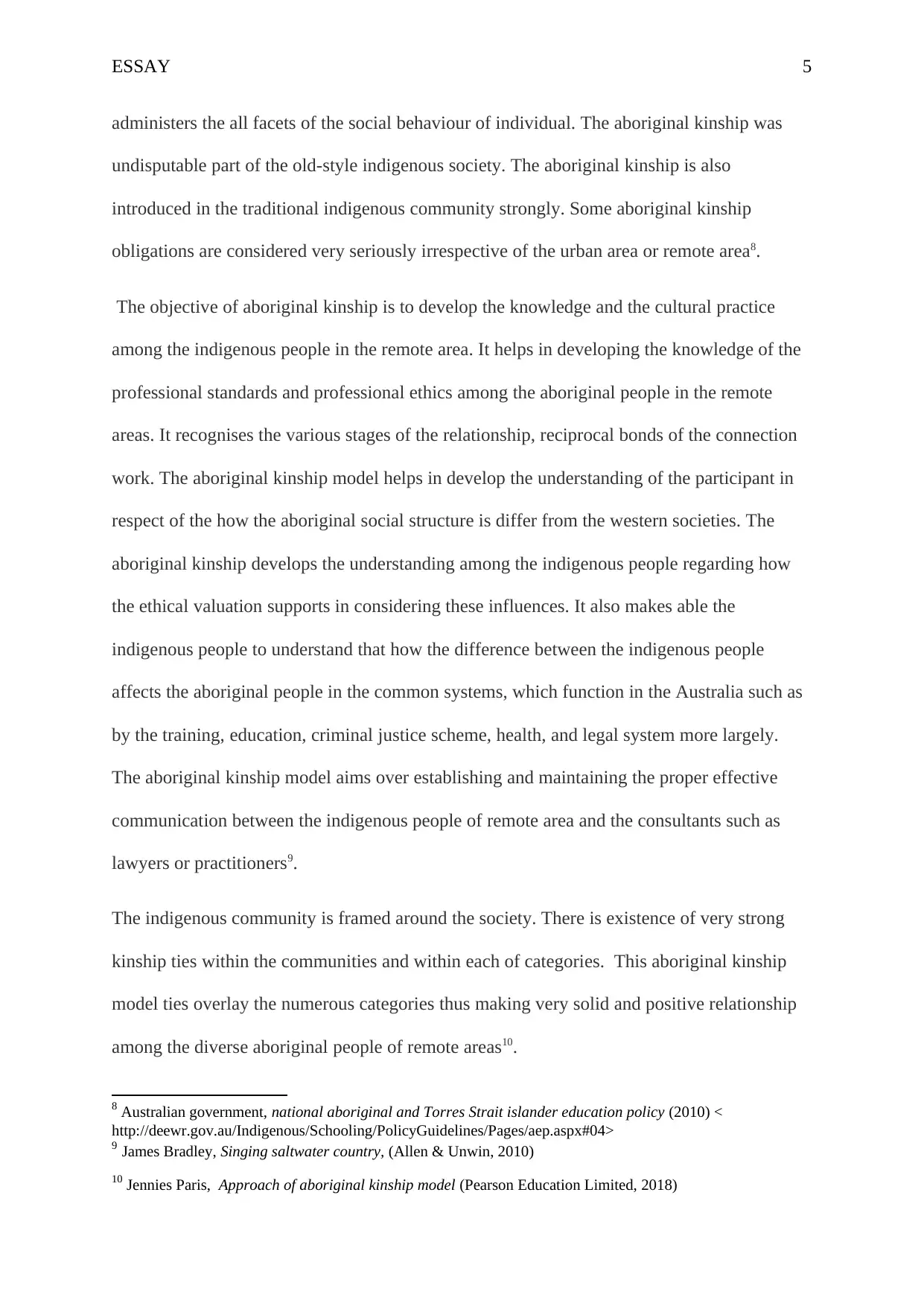
ESSAY 5
administers the all facets of the social behaviour of individual. The aboriginal kinship was
undisputable part of the old-style indigenous society. The aboriginal kinship is also
introduced in the traditional indigenous community strongly. Some aboriginal kinship
obligations are considered very seriously irrespective of the urban area or remote area8.
The objective of aboriginal kinship is to develop the knowledge and the cultural practice
among the indigenous people in the remote area. It helps in developing the knowledge of the
professional standards and professional ethics among the aboriginal people in the remote
areas. It recognises the various stages of the relationship, reciprocal bonds of the connection
work. The aboriginal kinship model helps in develop the understanding of the participant in
respect of the how the aboriginal social structure is differ from the western societies. The
aboriginal kinship develops the understanding among the indigenous people regarding how
the ethical valuation supports in considering these influences. It also makes able the
indigenous people to understand that how the difference between the indigenous people
affects the aboriginal people in the common systems, which function in the Australia such as
by the training, education, criminal justice scheme, health, and legal system more largely.
The aboriginal kinship model aims over establishing and maintaining the proper effective
communication between the indigenous people of remote area and the consultants such as
lawyers or practitioners9.
The indigenous community is framed around the society. There is existence of very strong
kinship ties within the communities and within each of categories. This aboriginal kinship
model ties overlay the numerous categories thus making very solid and positive relationship
among the diverse aboriginal people of remote areas10.
8 Australian government, national aboriginal and Torres Strait islander education policy (2010) <
http://deewr.gov.au/Indigenous/Schooling/PolicyGuidelines/Pages/aep.aspx#04>
9 James Bradley, Singing saltwater country, (Allen & Unwin, 2010)
10 Jennies Paris, Approach of aboriginal kinship model (Pearson Education Limited, 2018)
administers the all facets of the social behaviour of individual. The aboriginal kinship was
undisputable part of the old-style indigenous society. The aboriginal kinship is also
introduced in the traditional indigenous community strongly. Some aboriginal kinship
obligations are considered very seriously irrespective of the urban area or remote area8.
The objective of aboriginal kinship is to develop the knowledge and the cultural practice
among the indigenous people in the remote area. It helps in developing the knowledge of the
professional standards and professional ethics among the aboriginal people in the remote
areas. It recognises the various stages of the relationship, reciprocal bonds of the connection
work. The aboriginal kinship model helps in develop the understanding of the participant in
respect of the how the aboriginal social structure is differ from the western societies. The
aboriginal kinship develops the understanding among the indigenous people regarding how
the ethical valuation supports in considering these influences. It also makes able the
indigenous people to understand that how the difference between the indigenous people
affects the aboriginal people in the common systems, which function in the Australia such as
by the training, education, criminal justice scheme, health, and legal system more largely.
The aboriginal kinship model aims over establishing and maintaining the proper effective
communication between the indigenous people of remote area and the consultants such as
lawyers or practitioners9.
The indigenous community is framed around the society. There is existence of very strong
kinship ties within the communities and within each of categories. This aboriginal kinship
model ties overlay the numerous categories thus making very solid and positive relationship
among the diverse aboriginal people of remote areas10.
8 Australian government, national aboriginal and Torres Strait islander education policy (2010) <
http://deewr.gov.au/Indigenous/Schooling/PolicyGuidelines/Pages/aep.aspx#04>
9 James Bradley, Singing saltwater country, (Allen & Unwin, 2010)
10 Jennies Paris, Approach of aboriginal kinship model (Pearson Education Limited, 2018)
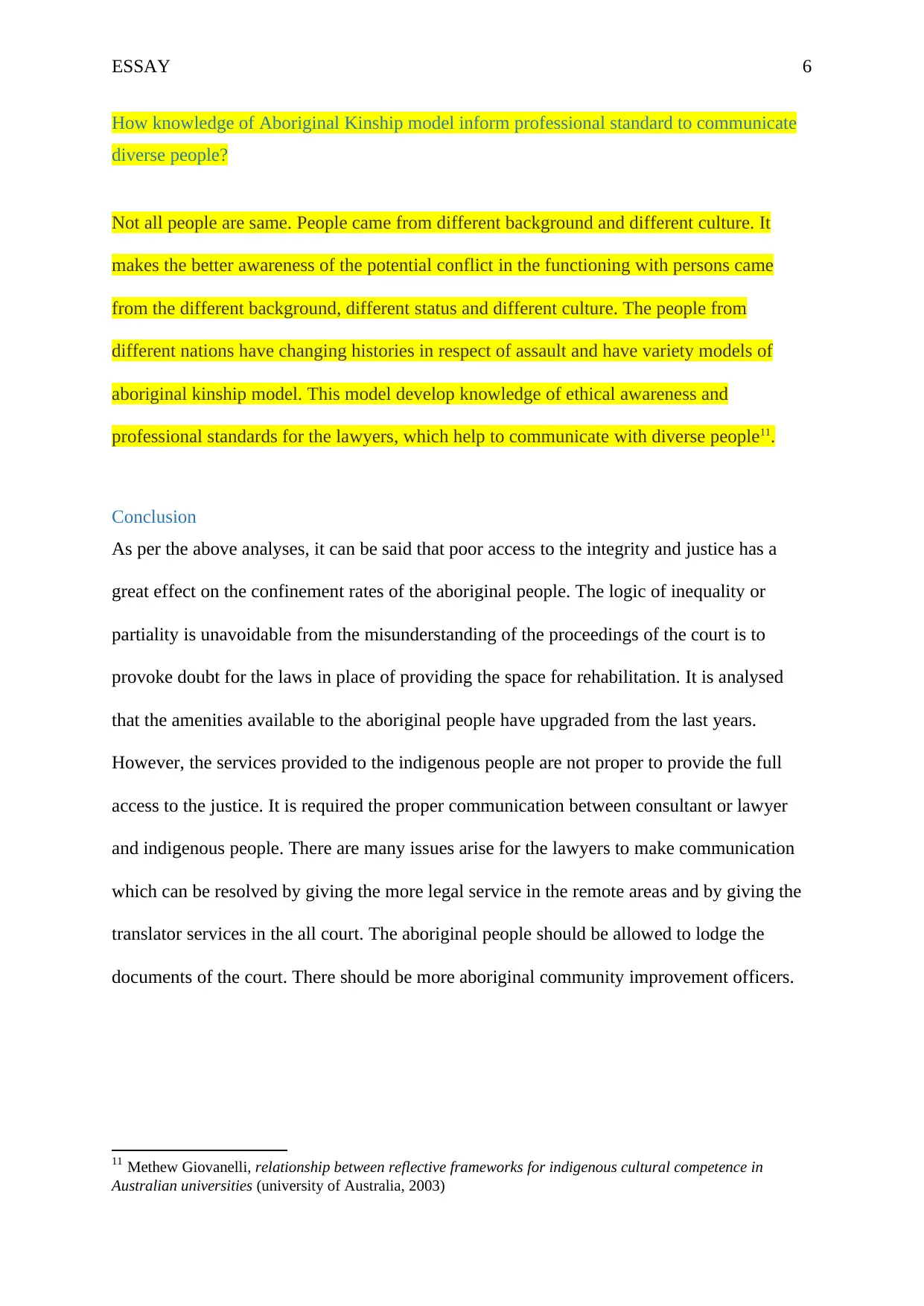
ESSAY 6
How knowledge of Aboriginal Kinship model inform professional standard to communicate
diverse people?
Not all people are same. People came from different background and different culture. It
makes the better awareness of the potential conflict in the functioning with persons came
from the different background, different status and different culture. The people from
different nations have changing histories in respect of assault and have variety models of
aboriginal kinship model. This model develop knowledge of ethical awareness and
professional standards for the lawyers, which help to communicate with diverse people11.
Conclusion
As per the above analyses, it can be said that poor access to the integrity and justice has a
great effect on the confinement rates of the aboriginal people. The logic of inequality or
partiality is unavoidable from the misunderstanding of the proceedings of the court is to
provoke doubt for the laws in place of providing the space for rehabilitation. It is analysed
that the amenities available to the aboriginal people have upgraded from the last years.
However, the services provided to the indigenous people are not proper to provide the full
access to the justice. It is required the proper communication between consultant or lawyer
and indigenous people. There are many issues arise for the lawyers to make communication
which can be resolved by giving the more legal service in the remote areas and by giving the
translator services in the all court. The aboriginal people should be allowed to lodge the
documents of the court. There should be more aboriginal community improvement officers.
11 Methew Giovanelli, relationship between reflective frameworks for indigenous cultural competence in
Australian universities (university of Australia, 2003)
How knowledge of Aboriginal Kinship model inform professional standard to communicate
diverse people?
Not all people are same. People came from different background and different culture. It
makes the better awareness of the potential conflict in the functioning with persons came
from the different background, different status and different culture. The people from
different nations have changing histories in respect of assault and have variety models of
aboriginal kinship model. This model develop knowledge of ethical awareness and
professional standards for the lawyers, which help to communicate with diverse people11.
Conclusion
As per the above analyses, it can be said that poor access to the integrity and justice has a
great effect on the confinement rates of the aboriginal people. The logic of inequality or
partiality is unavoidable from the misunderstanding of the proceedings of the court is to
provoke doubt for the laws in place of providing the space for rehabilitation. It is analysed
that the amenities available to the aboriginal people have upgraded from the last years.
However, the services provided to the indigenous people are not proper to provide the full
access to the justice. It is required the proper communication between consultant or lawyer
and indigenous people. There are many issues arise for the lawyers to make communication
which can be resolved by giving the more legal service in the remote areas and by giving the
translator services in the all court. The aboriginal people should be allowed to lodge the
documents of the court. There should be more aboriginal community improvement officers.
11 Methew Giovanelli, relationship between reflective frameworks for indigenous cultural competence in
Australian universities (university of Australia, 2003)
Paraphrase This Document
Need a fresh take? Get an instant paraphrase of this document with our AI Paraphraser
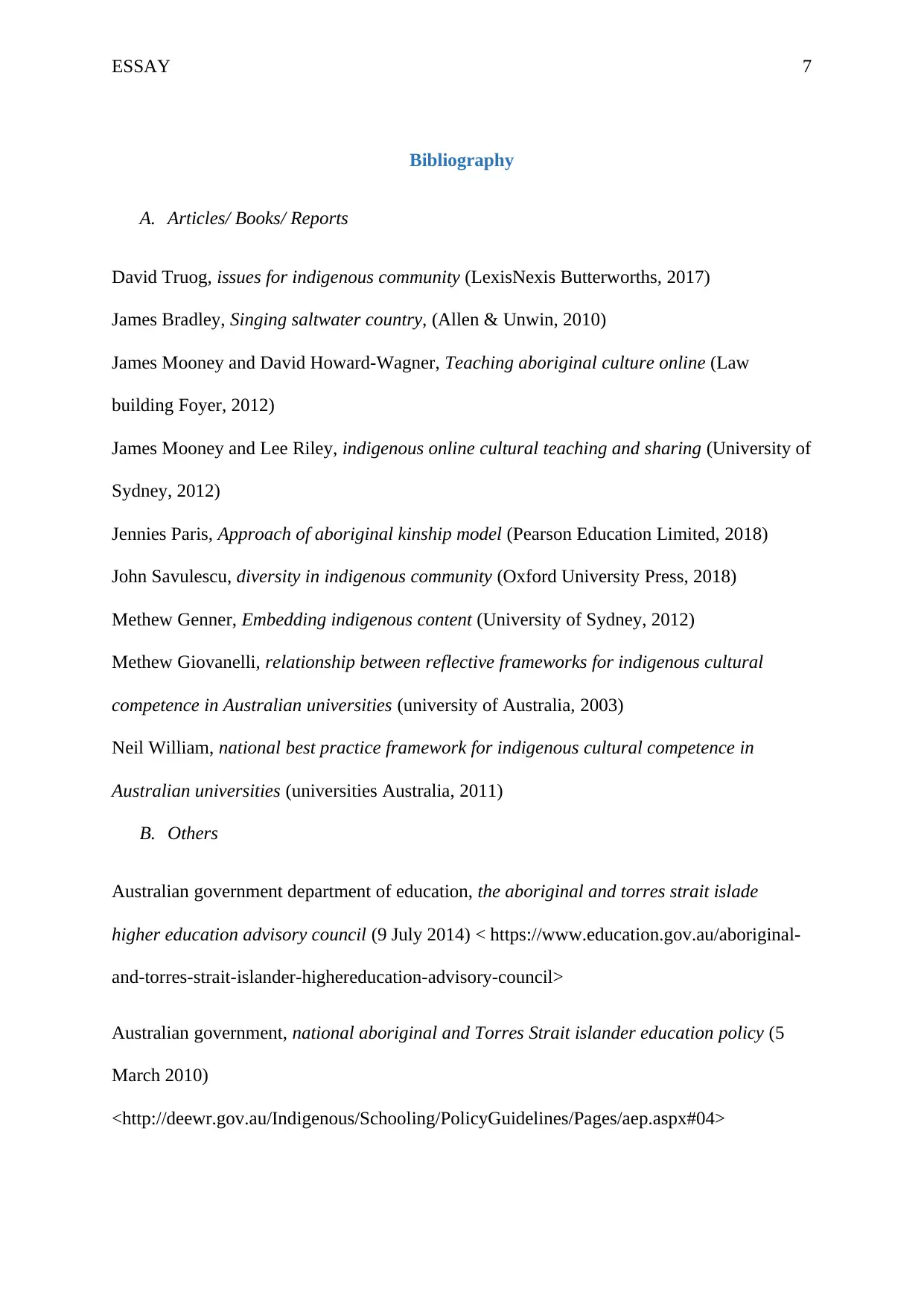
ESSAY 7
Bibliography
A. Articles/ Books/ Reports
David Truog, issues for indigenous community (LexisNexis Butterworths, 2017)
James Bradley, Singing saltwater country, (Allen & Unwin, 2010)
James Mooney and David Howard-Wagner, Teaching aboriginal culture online (Law
building Foyer, 2012)
James Mooney and Lee Riley, indigenous online cultural teaching and sharing (University of
Sydney, 2012)
Jennies Paris, Approach of aboriginal kinship model (Pearson Education Limited, 2018)
John Savulescu, diversity in indigenous community (Oxford University Press, 2018)
Methew Genner, Embedding indigenous content (University of Sydney, 2012)
Methew Giovanelli, relationship between reflective frameworks for indigenous cultural
competence in Australian universities (university of Australia, 2003)
Neil William, national best practice framework for indigenous cultural competence in
Australian universities (universities Australia, 2011)
B. Others
Australian government department of education, the aboriginal and torres strait islade
higher education advisory council (9 July 2014) < https://www.education.gov.au/aboriginal-
and-torres-strait-islander-highereducation-advisory-council>
Australian government, national aboriginal and Torres Strait islander education policy (5
March 2010)
<http://deewr.gov.au/Indigenous/Schooling/PolicyGuidelines/Pages/aep.aspx#04>
Bibliography
A. Articles/ Books/ Reports
David Truog, issues for indigenous community (LexisNexis Butterworths, 2017)
James Bradley, Singing saltwater country, (Allen & Unwin, 2010)
James Mooney and David Howard-Wagner, Teaching aboriginal culture online (Law
building Foyer, 2012)
James Mooney and Lee Riley, indigenous online cultural teaching and sharing (University of
Sydney, 2012)
Jennies Paris, Approach of aboriginal kinship model (Pearson Education Limited, 2018)
John Savulescu, diversity in indigenous community (Oxford University Press, 2018)
Methew Genner, Embedding indigenous content (University of Sydney, 2012)
Methew Giovanelli, relationship between reflective frameworks for indigenous cultural
competence in Australian universities (university of Australia, 2003)
Neil William, national best practice framework for indigenous cultural competence in
Australian universities (universities Australia, 2011)
B. Others
Australian government department of education, the aboriginal and torres strait islade
higher education advisory council (9 July 2014) < https://www.education.gov.au/aboriginal-
and-torres-strait-islander-highereducation-advisory-council>
Australian government, national aboriginal and Torres Strait islander education policy (5
March 2010)
<http://deewr.gov.au/Indigenous/Schooling/PolicyGuidelines/Pages/aep.aspx#04>
1 out of 8
Related Documents
Your All-in-One AI-Powered Toolkit for Academic Success.
+13062052269
info@desklib.com
Available 24*7 on WhatsApp / Email
![[object Object]](/_next/static/media/star-bottom.7253800d.svg)
Unlock your academic potential
© 2024 | Zucol Services PVT LTD | All rights reserved.





